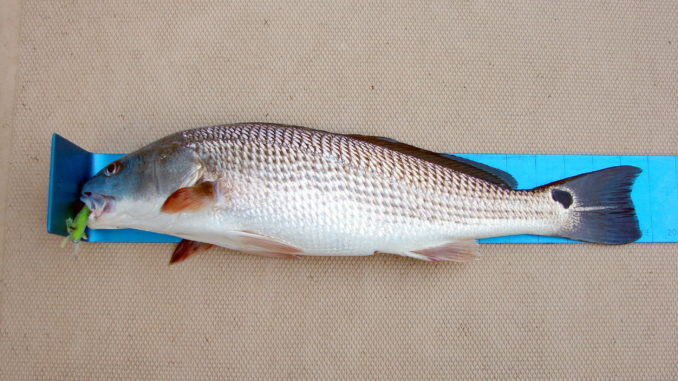
In a stunning vote against conservation on July 17, the Red Drum Advisory Committee voted in favor of increasing the daily commercial trip limit 43% while keeping the recreational bag limit the same.
While this vote does not in and of itself raise the commercial trip limit, the NC Marine Fisheries Commission must approve such a regulation, it is a significant step in the wrong direction.
Red drum have been under management for over twenty years, but due to liberal regulations in the past that did not curb harvest, the desired management goals were never achieved. The last Red Drum Fishery Management Plan, implemented in 1999, reduced the recreational bag limit by 80% (from 5 fish to 1 fish/day), which the recreational folks supported in order to recover the species.
The commercial “cap” was set at 250,000 pounds, a number only exceeded 4 times previously and well above the annual average. An initial 100-pound daily trip limit was also implemented for commercial fishermen.
The commercial fishery was to be a “bycatch” fishery and not designed to target red drum. The 250,000-pound cap was promptly exceeded substantially in 1999 and 2000. Thus a 7 fish trip limit was established for the 2001 season and a netter must have equal poundage of other fish in order to possess the 7 red drum. This regulation, crafted and supported by the NC Division of Marine Fisheries staff, prevented commercial gill netters from targeting red drum, but allowed them to keep a few caught incidentally.
Not surprisingly, the stringent regulations have worked. Escapement has increased and is approaching the target of 40 per cent, thus the red drum population is on the road to recovery. It is not recovered, as escapement simply means we are allowing 40 percent of the juvenile population to “escape” to spawning age. They will have to escape for years to re-establish the historic age structure and spawning stock required by red drum as this species lives in excess of 30 years.
On Tuesday July 17, at a meeting of the Red Drum Advisory Committee, an advisory committee to the NC Division of Marine Fisheries, the netters played their hand. Despite the conservation regulations that clearly worked, they want to be allowed to keep more red drum, right now. They want to increase the trip limit to 10, against the professional advice of the Division of Marine Fisheries biologists, who recommended keeping the regulations the same (since they are working) and allowing red drum to fully recover.
“This makes no sense,” said Bill Mandulak, president of the Coastal Conservation Association of North Carolina. “Red drum are recovering from years of abuse and right when we get them on the right track the netters want to cut into those gains.”
“This is a conservation issue all recreational fishermen should support,” Mandulak said. “For once we have a fish on the right path to recovery; we need to be certain our regulations keep us on that path. After all, if we keep the current regulations our only risk is that we have more and bigger fish in the future. That’s what we all want.”
The stated purpose of the Coastal Conservation Association North Carolina is to advise and educate the public on conservation of marine resources, while the objective of CCA is to conserve, promote and enhance the present and future availability of these coastal resources for the benefit and enjoyment of the general public. For more information, visit www.ccanc.org.
A listing of contact information for the members of the Red Drum Advisory Committee and the Marine Fisheries Commission is below. Please contact them and make them aware of your feelings on this situation. The vote will not become a regulation until approved by the Marine Fisheries Commission.
Red Drum Fishery Management Plan Advisory Committee
Co-Chairs: Charlie Adams and Fred Scharf
Dr. Christopher Taylor,252-222-6346, chris_taylor@ncsu.edu
Sarah Jackson, 910-962-3092, topsailisl@yahoo.com
Eugene Ballance, 252-921-0123, geneb12@beachlink.com
Willie Etheridge, 252-473-5272
Frank Folb, 252-995-4171, ffff1@interpath.com
Thomas Hardison, 252-551-2066, hardistw@gvc.com
George Beckwith, Jr., 252-249-3101, info@pamlicoguide.com
Tommy McArthur, 252-728-7428, TommyMcArthur242@hotmail.com
Norman Miller, Jr., 252-921-0180, fishrascal@gmail.com
Dr. Fred Scharf, 910-962-7796, scharff@uncw.edu
Ken Seigler, 910-326-33328, BRCRKSFD@ec.rr.com
David Smith, 910-458-0486, SSS@qson.net
Charlie Adams, 252-355-5566, adams@adamsadv.com
William Mandulak, 919-876-2983, wreelfun@cs.com
Charles (Bernie) McCants, Jr., 919-668-8764, Bernie.McCants@duke.edu
NCDMF Staff assigned to committee:
Dr, Louis Daniel, DMF, 252-726-7021, Louis.Daniel@ncmail.net
Jim Kelley, DMF, 910-395-3900, Jim.Kelley@ncmail.net
Lee Paramore, DMF, 252-473-5734, Lee.Paramoore@ncmail.net
North Carolina Marine Fisheries Commission
Mac Currin – Chairman, 919-881-0049, mcurrin1@bellsouth.net
Dr. B.J. Copeland – Vice Chairman, 919-837-5024, bjjvc@emji.net
Dr. James R. Leutze, 910-962.7662, Leutzej@uncw.edu
Dr. Barbara Garrity-Blake, 252-729-8021, bgb@coastalnet.com
David A. Beresoff, 910-842-8388
Bradley Styron, 252-225-0073, qualityseafood@clis.com
Marshall Williford, 252-325-0193, MarshallWilliford@hotmail.com
Mikey Daniels, 252-473-5001, nccroakerjoe@yahoo.com 06/30/09
William T. (Rusty) Russ, 910-754-6596, a054206@allstate.com



Be the first to comment